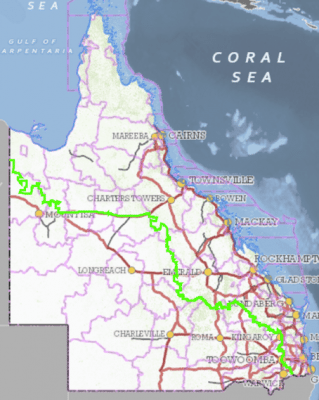
Queensland’s new cattle tick control line. Click on image to view the full map on the Qld Dept of Ag website.
Changes to the location of the cattle tick control line have been announced as part of a new cattle tick management framework in Queensland, announced by the State’s Agriculture and Fisheries Minister Leanne Donaldson.
“As of 1 July 2016, part of Queensland will be designated as a tick free zone, and the remainder will be designated as a tick infested zone,” Minister Donaldson said.
“We’ve simplified and strengthened the tick line by removing the confusing control zone and in some areas aligning the tick line with stronger double fenced boundaries.
“The new framework will provide greater flexibility for producers, reduce travel times, reduce costs for industry, and most importantly it will continue to protect the cattle tick free zone.
“We have continually heard from producers that a one size fits all approach does not work and livestock owners want control of biosecurity decisions that impact their businesses.
“The changes I am announcing today ends decades of uncertainty and contention.”
Minister Donaldson said she had made her decision after listening to advice from producers, delegations from industry and guidance from the Department.
“There has been extensive consultation on the tick line.
“More than 1000 surveys were collected during the consultation on the location of the tick line, as well as submissions from industry groups and feedback collected during producer meetings.
“More than 1000 producers attended information and consultation meetings and I have received delegations and visited areas of contention around Kingaroy, Hughenden and Durong.
“I have listened to the concerns that were expressed and, wherever possible, acted to meet the wishes of the majority of producers.
“The consultation was around three options. The decision is to adopt Option Three, but with amendments based on the feedback from industry and individuals.”
The Minister said she wanted to ensure that producers who had attempted to control ticks without success would not be disadvantaged by being placed in a position where they were obliged to eradicate.
“There will be an opportunity to review the tick line once we see how it impacts producers.
“In two years the Department will assess the effectiveness of eradication and I will look to adjust the line accordingly.”
Queensland’s Chief Veterinary Officer Allison Crook said to minimise the risk of cattle tick spreading into the free zone, control of high risk livestock moving into the free zone will be maintained, but with more flexibility.
“When crossing from the infested zone to the free zone, producers can have their livestock certified tick free by an accredited certifier at any location, including their own property,” said Dr Crook.
“This will reduce transportation costs, helping to sustain our profitable primary industries and improve animal welfare.
“Owners of low risk livestock, such as horses and sheep, will have an obligation to only move tick free animals into the tick free zone, but an accredited certifier will not have to assess their animals.
“Biosecurity Queensland inspectors will implement a cattle tick surveillance program that will monitor livestock movements and ensure cattle ticks in the free zone aren’t spreading.”
Cattle tick and tick fever will continue to be notifiable when they occur in the free zone.
Property owners will be required to eradicate cattle ticks if their property becomes infested in the free zone.
The new cattle tick management framework will commence with the Biosecurity Act 2014 on 1 July 2016.
For more information and to view the cattle tick line map visit www.biosecurity.qld.gov.au and follow the link.
Wins and losses for South Burnett tick line graziers
Deputy opposition leader and member for Nanango Deb Frecklington said petitioning had paid off for several groups of graziers in regards to the positioning of the tick line, while others have lost out completely.
Mrs Frecklington said four out of the eight groups who submitted petitions through her office had achieved the outcome they were seeking, while the four other groups had been denied their requests.
“This means that the Minister ignored the feedback of half of the primary producers in my region, many of whom had had spent a great deal of time trying to demonstrate to the Government their opinion on the location of the tick line,” Mrs Frecklington said.
“Hundreds of producers, who have spent thousands and thousands of dollars over the years on keeping their properties tick free will now find themselves in the dirty zone.
“Option three was not the choice of the majority of landowners and it takes a step backwards for large areas of the grazing land. I know many land managers who will be extremely disappointed with this outcome.
“I am pleased however that the petitions I was able to present to the Minister for half of the groups were successful and they have have achieved the outcome they wanted.
“I was particularly disappointed though that when the Minister for Agriculture released her statement on the new tick line, the maps were not available until nearly two hours after the announcement.
“We have had hundreds of producers waiting on this announcement for months, and when it did come, the Department didn’t even have the courtesy of putting the maps up on the website,” Mrs Frecklington said.
